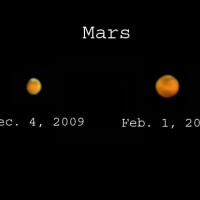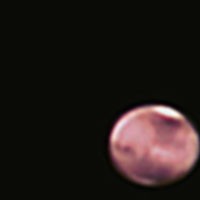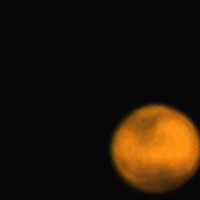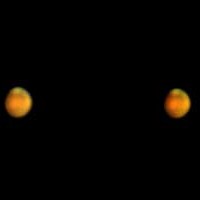The Return of Mars
February 2010 :
Note: This article may contain outdated information
This article was published in the February 2010 issue of The Skyscraper and likely contains some information that was pertinent only for that month. It is being provided here for historical reference only.
It’s been two years since I’ve written about our planetary neighbor Mars. Why? As it is with most things astronomical, events in our solar system occur in a cyclic manner. Earth and Mars have a close encounter every 26 months. During the last few months the Earth has been catching up to Mars in our respective orbits. Back on January 27 these two planets approached each other to within 61,721,726 miles at their closest. That distance is still quite large, considering back on August 27, 2003, the Earth and Mars were only 34,646,418 miles apart. Unfortunately not all Mars close encounters are favorable ones. That fact is due to the eccentricity of Mars’ elliptical orbit and its distance from the Sun.
Some of my associates have already been observing and imaging Mars with their telescopes. They’ve had to schedule their observing time for the late hours of the night or wee early morning ones when Mars gained some altitude in our sky. Skyscrapers member Tom Thibault of Blackstone, Massachusetts, took the accompanying Martian image back on December 4 between four and five am when Mars was still 85,696,854 miles from the Earth. It’s a nice image, considering how small Mars appeared in the eyepiece of the telescope. More about what the image shows a little further on.
For those of you who enjoy observing at more reasonable hours, this brief Mars observing guide will help you to discern and appreciate the planetary detail a telescope may show you of this desolate world. While this apparition is not one of the closer ones, medium sized backyard telescopes should still coax some detail out of the small image. And of course the local observatories will be able to share even more Martian detail if we get a reprieve from all the snow we’ve been receiving.
The current apparition of Mars positions it almost twice as far from the Earth as it was during the 2003 encounter, and that fact means the apparent size of the Martian disk is almost less than half the size it was back then. And now that we have “lapped” Mars in our respective orbits, Mars’ image size will gradually be getting smaller. Due to our greater orbital speed we will be pulling away from Mars at about half a million miles per week. Make no mistake about it. Observing details on the Martian surface is going to be a challenge for small telescopes.
The one favorable circumstance during this Mars observing season is that its hourly progression across the sky will take it high overhead, thereby escaping any horizon haze and turbulence, providing we have steady seeing conditions overall. This factor will certainly help to counter the tiny image, which can easily be distorted by the smallest amount of atmospheric turbulence.
Even if you have a small telescope I encourage you to try observing Mars. First you will need to locate Mars in the sky. At around 8:00 pm on February 1st Mars will be about 40 degrees (about halfway) above the eastern horizon in the constellation of Cancer. This star pattern is to the upper right of Leo, a portion of which looks like a backwards question mark, with the bright star Regulus as the period in the question mark. Mars will also be quite near the Beehive Cluster of stars, easily visible from a dark sky location. And Mars can’t be missed, since its bright pumpkin orange color will certainly pinpoint its location.
Since Mars’ north pole is currently tilted towards the Earth, the first detail that should catch your attention will be the North Polar Cap (NPC). That feature is the bright spot at the top of Tom’s image. Spring in Mars’ northern hemisphere began back on October 27 of 2009, so the NPC has had some time to melt. As more time passes, an observer should be able to notice the NPC shrinking and breaking up. Mars’ image will be fairly small, so one should wait for steady seeing conditions to observe as much detail as possible. While the NCP will continue to shrink, the Earth/Mars distance will be increasing and the image size will be decreasing. Summer begins in Mars’ northern hemisphere on May 13, but by then the image will be even smaller, since the planet will be about 129 million miles away. For this apparition of Mars an observer should “crank up’ the magnification (power) as far as possible without severely distorting the image.
While the NPC should be rather apparent, the rest of the planet will appear as a rust-colored beach ball. However, several dark features can also be seen. Notice the dark feature in upper right below the NCP in Tom’s image. Utilizing a JavaScript utility called Mars Profiler provided online by Sky & Telescope magazine (http://www.skyandtelescope.com/observing/objects/javascript/mars), Tom was able to identify the area as Mare Acidalium and Niliacus Lacus. These features are the underlying rock exposed by the shifting sands during intense dust storms. The relatively small image will make it somewhat of a challenge to identify much detail, and the dark surface features may be fleeting. Despite this handicap a keen-eyed observer should be able to catch a few glimpses of a dark area like Syrtis Major or a bright one like Hellas Basin.
Also please keep in mind that Mars rotates once in 24 hours and 38 minutes. That means if you observe a feature at a specific location at a specific time on one night, you’ll have to wait an additional 38 minutes each successive night for it to be at the same spot, since the Earth rotates once every 24 hours.
In conclusion, be patient when observing Mars. The planet’s disk will be small. Wait for steady seeing conditions. Don't try observing Mars if the stars are twinkling. Take your time in observing this fascinating planetary neighbor, and your efforts will be well rewarded.
If you don’t own your own telescope, or the view through the one you do own is too small to see much detail, plan on visiting Seagrave Observatory (http:/www.theskyscrapers.org) on Peeptoad Road in North Scituate on any clear Saturday night (7-9pm). You can also visit Ladd Observatory (http://www.brown.edu/Departments/Physics/Ladd/) located on Hope Street on Providence’s East Side on any clear Tuesday night (7-9pm). Dress warmly and take advantage of the views their larger telescopes can provide. Please check the above websites for any cancellation notices before venturing out for a visit, since snow and ice at the facilities can force closures even when the skies are clear.
Keep your eyes to the skies.









